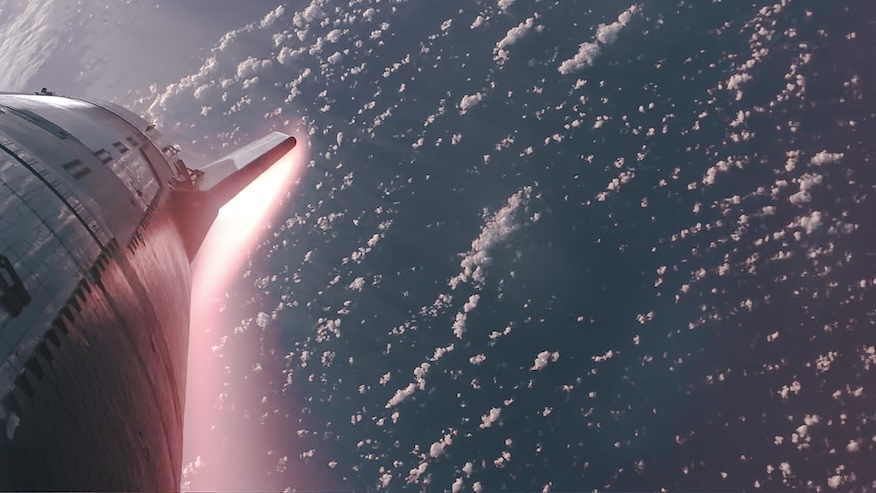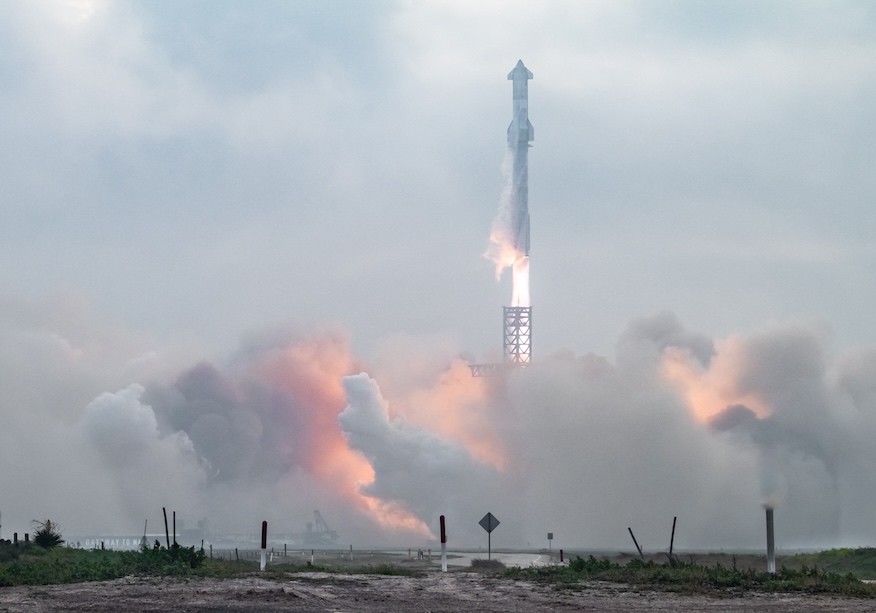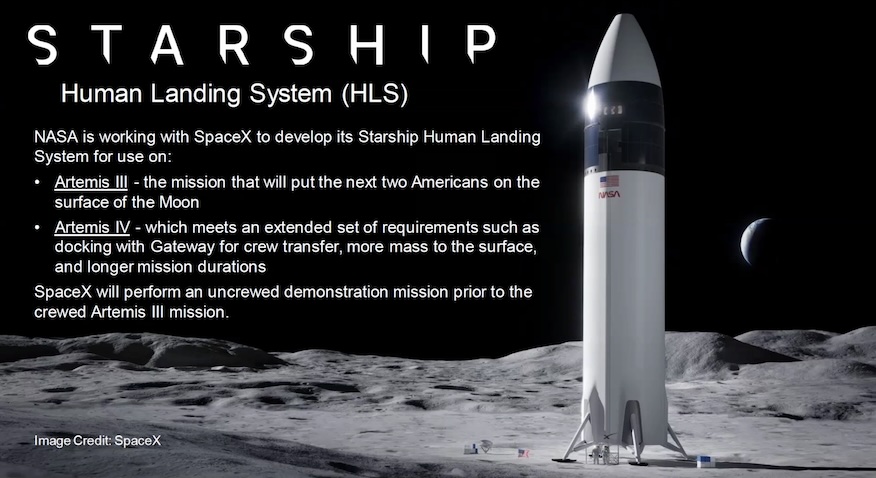
SpaceX is preparing to launch its massive Starship rocket on its fourth flight test from its Starbase facility in South Texas as early as June 5. The target launch date comes just under three months after Flight 3, on March 14.
In two articles on its website, SpaceX outlined the learnings from Flight 3, the mission objectives of Flight 4, and the differences in the timing of everything between these two elements of the development campaign.
The Flight 4 launch window is scheduled to open on June 5 at 7 a.m. CDT (8 a.m. EDT (1200 UTC). However, as SpaceX points out, they are still awaiting regulatory approval from the Federal Aviation Administration (FAA).
During this final go-around, SpaceX will not attempt some of the additional flight operations it tried during Flight 3, such as operating the payload bay door or restarting the upper stage’s vacuum engines.
“The fourth flight test shifts our focus from achieving orbit to demonstrating the ability to return and reuse Starships and Super Heavys,” SpaceX said in a statement. “The primary objectives will be to achieve a soft landing and watering in the Gulf of Mexico with the Super Heavy booster, and to achieve a controlled entry of the Starship.”
Lessons learned
In a blog post, SpaceX described a number of elements of Flight 3 that went as planned and others that led to the accident. Successes included completing a propellant transfer demonstration, “moving liquid oxygen from a main tank to the main tank.”
“This test provided valuable data for possible ship-to-ship fuel transfers that will enable missions such as returning astronauts to the Moon as part of NASA’s Artemis program,” SpaceX said in a press release.
As with Flight 2, Flight 3 also saw a successful ascent of the rocket via stage separation. Building on this second flight, the most recent go-around also saw the Starship’s upper stage undergo a full ascent.
However, during Flight 3, SpaceX said a clogged filter “where liquid oxygen is supplied to the engines” on the Super Heavy booster caused “a loss of inlet pressure to the engine’s oxygen turbopumps.” He said this was likely the root cause of the early shutdown of six of the 13 Raptor engines used during the boostback burn.

Upon landing, all six engines that shut down prematurely were deactivated and of the remaining seven engines, only two were determined to have successfully “ignited the core stage”.
“The booster had lower landing thrust than expected when contact was lost at approximately 462 meters altitude above the Gulf of Mexico and just under seven minutes into the mission,” explained SpaceX.
SpaceX said more hardware improvements in the oxygen tanks are coming for the Flight 4 Super Heavy booster and those beyond “to further improve the propellant’s filtration capabilities.” They will also add new hardware and software “to increase the starting reliability of Raptor engines under landing conditions.”
During re-entry from space, the Starship’s upper stage suffered from a lack of attitude control, noted when the rocket began rolling unintentionally, leading “the ship to see significantly more heating.” greater than expected in protected and unprotected areas.
“The most likely cause of the unplanned rollover was clogging of the valves responsible for controlling the rollover,” the company said. “SpaceX has since added additional roll control thrusters on upcoming spacecraft to improve attitude control redundancy and improved hardware for better jam resilience.”
Timeline adjustments
In addition to some hardware and software changes, close observers of the mission schedule will also notice other key differences. One of the notable changes ahead of launch is the refueling process.
During Flight 3, SpaceX began by loading the Starship’s upper stage with liquid oxygen at T-53 minutes, followed by loading liquid methane onto the ship two minutes later. Flight 4 reverses this and stars with liquid methane first at T-49 minutes, then liquid oxygen two minutes later.
Similarly, on the Super Heavy booster, Flight 3 started with a liquid oxygen load at T-42 minutes, then liquid methane a minute later. Flight 4 begins with liquid methane at T-40 minutes, then liquid oxygen three minutes later.
SpaceX hasn’t given a reason for the reversals in the refueling process, but they have done a lot of work to modify the liquid oxygen and liquid methane storage tanks in the tank farm near the platform . The vertical tanks have been replaced by horizontal tanks in recent months as part of the work on the ground systems.
In total, Starship’s refueling time is expected to be about four minutes shorter than the last flight. It also only takes about 11 minutes longer than it takes to fully fuel a Falcon 9 rocket.
Flight 4 launch rehearsal completed pic.twitter.com/Gh8s7n4JIQ
– SpaceX (@SpaceX) May 20, 2024
The launch schedule is also somewhat changed. While the end of the mission, described as “An exciting landing!” » stays at about the same time (around 1 hour and 5 minutes), Flight 4 streamlines a lot by removing some of the extra flight objectives.
Three key events were added to the timeline, however, one near liftoff and two near the end of the mission.
After the Super Heavy booster completes the boostback burn, just before the four-minute mark, SpaceX will jettison the hot stage adapter, which was added between Starship’s first and second flights.
SpaceX said it was doing this “to reduce propellant mass for the final phase of flight.”
The other two events added during the next go-around include the so-called “landing flip” at T+01:05:38, followed by the landing burn five seconds later.
“Flight 4 will follow a similar trajectory to the previous flight test, with Starship destined to crash into the Indian Ocean,” SpaceX said. “This flight path does not require deorbiting for reentry, thereby maximizing public safety while providing the opportunity to achieve our primary goal of a controlled spacecraft reentry.”
Launch path
As SpaceX noted Friday, the planned launch date of Wednesday, June 5 is contingent on FAA approval. SpaceX’s accident investigation after Flight 3 is still ongoing, but the company hopes to use a pre-existing authorization mechanism under FAA rules to resume flying before the investigation is fully closed.
“During Flight 3, none of the vehicles’ automated flight safety systems were triggered and no vehicle debris was impacted outside of predefined danger zones,” SpaceX said. “Pending the FAA’s conclusion that there is no impact to public safety, a license modification for the next flight may be issued without formal closure of the accident investigation.”
When reached for comment on Friday, the FAA told Spaceflight Now that it had received SpaceX’s request for a public safety determination and that if they agreed, SpaceX could in fact fly while l The investigation into the accident was progressing.
“The FAA is responsible for and committed to protecting the public during commercial space transportation launch and re-entry operations,” the FAA said. “On April 5, SpaceX requested a public safety decision from the FAA as part of the ongoing investigation into the Starship OFT-3 accident. The FAA is reviewing the application and will be guided by data and safety every step of the way.

Getting to launch as much and as often as possible is important to SpaceX’s development process as well as to NASA. The rocket is under contract to support a crewed landing on the Moon’s surface during the Artemis 3 mission, currently scheduled for September 2026. A delay of almost a year from its previous date of December 2025 has been announced by NASA earlier this year.
At a budget hearing with the Senate Appropriations Committee earlier this week, NASA Administrator Bill Nelson said he was closely monitoring Starship’s development as Flight 4 approaches.
“Artemis 3, if you compare it to the Apollo program, is a combination of Apollo 9, 10 and 11, which corresponded to the moon landing, and part of Apollo 8 which circled the Moon ten times , Nelson said, “It’s a difficult task and whether we land depends on SpaceX’s ability to prepare its lander.”
“Now they’ve completed all their milestones and in a few weeks they’re going to launch this huge rocket that has 33 Raptor engines in its tail, and they’re going to do more to show off its space capability,” Nelson added. “I hope SpaceX will be ready with its lander.”
Speaking before the Senate Appropriations Committee Admin. Nelson is referring to the upcoming SpaceX Starship IFT-4 launch and its role in the path to Artemis III.
Watch: pic.twitter.com/VC6gWXTY3a
– Will Robinson-Smith🚀 (@w_robinsonsmith) May 23, 2024